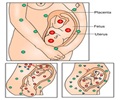First-time mothers who had induced labor at 39 weeks were at less risk of cesarean delivery and other serious complications compared to those induced after 41 weeks. It is better to induce than to watch and wait, was the result of a new study by researchers at the University of South Florida Morsani College of Medicine. The study was published in PLOS ONE.
Obstetricians generally recommend the procedure at that point since the pregnancy is considered "late-term" and the placenta has more difficulty providing essential nutrients and oxygen to the fetus, increasing the chances of stillbirth and risks to the mother.
‘It is better to induce than to watch and wait. Inducing labor at 39 weeks showed healthier babies for first-time moms.’
There's long been uncertainty about what happens during that three-week timeframe. So USF researchers simulated patient outcomes by creating a rigorous mathematical model based on 100,000 patients, data collected by the National Institute of Health's Safe Labor Consortium. They found compared to elective induction at 39 weeks, waiting to induce labor until after 41 weeks resulted in increased:
- C-section rates (35.9 vs. 13.9 percent)
- Maternal complications, such as preeclampsia and uterine rupture (21.2 vs. 16.5 percent)
- Stillbirths (0.13 vs. 0 percent)
- Newborn deaths (0.25 vs. 0.12 percent)
- Severe neonatal complications, such as respiratory distress and shoulder dystocia (12.1 vs. 9.4 percent)
"Safely preventing primary cesarean deliveries, stillbirths and reducing other perinatal complications are of the greatest concern," said principal investigator Charles J. Lockwood, MD, senior vice president for USF Health and dean of the Morsani College of Medicine. "Sometimes clinicians do something because that is the way it's always been done. These findings demonstrate the importance of strong evidence-based research in informing and shaping standards of care."
Source-Eurekalert












